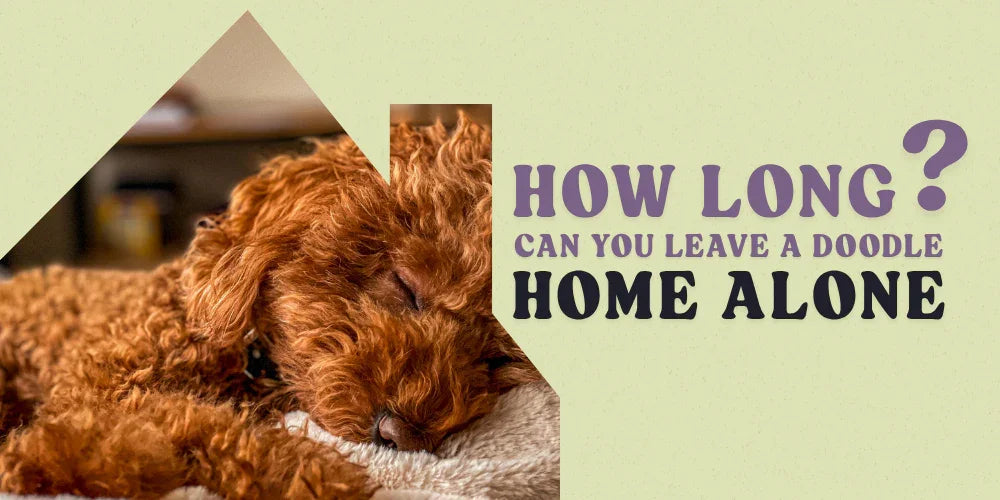
How Long Can You Leave a Doodle Home Alone
|
|
Time to read 5 min
|
|
Time to read 5 min
Hey there, Doodle Owners! Elina here.
Many Doodle owners have the challenge of balancing work, errands, and their dog's need for company.
Questions about how long you can leave a Doodle home alone come up often, especially for those with busy schedules.
Doodles tend to be people-oriented dogs, but with the right approach, they can learn to spend time by themselves comfortably.
The key lies in understanding your dog's specific needs and building up to longer periods gradually. Most healthy adult Doodles can manage around 6 to 8 hours alone, but this varies widely based on several factors.
We'll walk through those elements next, so you can make informed choices for your own situation.
Age, temperament, and training play the most important roles in how well your Doodle handles time alone. Considering these helps set realistic expectations and prevents problems down the line.
A Doodle's age directly affects their physical ability to stay alone.
Younger dogs have limited bladder control and higher energy levels, while older ones might need more frequent breaks or comfort measures.
This factor often guides the starting point for any alone time routine.
Some Doodles are naturally independent and relax easily when left alone, while others become anxious quickly.
Breed mixes can influence this trait, with some showing more attachment behaviors than others.
Observing your dog's baseline personality helps predict how they'll respond to alone time.
Dogs with established routines and positive experiences of being alone tend to handle longer periods better.
Consistent training builds confidence over time. Without it, even leaving for 10 minutes can lead to stress or unwanted behaviors such as destruction and chewing.
Building on these factors, let's look at specific time recommendations tailored to different life stages. Please remember, these are just starting points and need to be adjusted based on your Doodle's response.
Frequent check-ins during this stage help them learn that alone time is temporary and safe.
Between 6 months and 2 years, Doodles can typically manage 4 to 6 hours alone.
This phase often includes higher energy and curiosity, which might lead to mischief if they're bored. Providing exercise before leaving will help your Doodle settle down more easily.
Adult Doodles from 2 to 7 years old usually handle 6 to 8 hours comfortably, assuming they've built up to it.
Some can go up to 10 hours occasionally, but regular breaks remain important for their well-being. At this stage, established habits make longer absences more feasible.
Senior Doodles over 7 years may need alone time limited to 4 to 6 hours.
Age-related changes can make them less tolerant of long periods without company or access to relief. More frequent outings or midday visits often work best here.
With these guidelines in mind, it's helpful to know what signals might indicate your Doodle needs adjustments to their alone time setup. Spotting issues early allows you to respond effectively.
Doodles sometimes show clear signs when alone time becomes too much for them.
These behaviors point to discomfort and suggest scaling back or adding more training.
Watch for patterns like these:
Noticing one or more of these means it's time to reassess your approach. From here, focus on training methods that build confidence step by step.
Training your Doodle to tolerate alone time requires patience and consistency. Begin with short sessions and expand as they improve.
Over weeks, this process helps most Doodles adapt. Once training is underway, setting up their space properly supports the effort.
A well-prepared environment makes alone time smoother for your Doodle. Focus on safety and comfort to minimize stress.
These simple steps create a secure spot where your Doodle feels at ease.
As you implement these ideas, certain products can enhance the setup and make the process easier.
Selecting tools that match your Doodle's needs can transform how they handle being alone.
Here are three options that many owners find helpful:
Puzzle toys engage your Doodle's brain and prevent boredom.
The Outward Hound by Nina Ottosson Dog Hide N' Slide Treat Puzzle Enrichment Toy challenges them to find hidden treats, providing mental exercise during your absence.
Remote training devices allow positive reinforcement even when you're not home.
The PetSafe Treat and Train Remote Reward Dog Trainer lets you dispense treats via an app, helping reinforce calm behavior from afar.
A Monitoring Camera allows you to see how they behave without your presence.
The Kasa Indoor Pan/Tilt Smart Security Camera has Real-Time Motion/Sound Detection, that allow you to react fast to the distress signals your dog may be giving.
Determining how long to leave your Doodle home alone involves considering their age, temperament, and training while watching for anxiety signs. Most adults manage 6 to 8 hours well after proper preparation, but puppies and seniors often need shorter periods.
Through gradual training and a supportive environment, you can help your Doodle become more independent. Every dog responds differently, so observe what works best for yours.
What's your biggest challenge with leaving your Doodle alone? Comment below with your experiences or questions!



